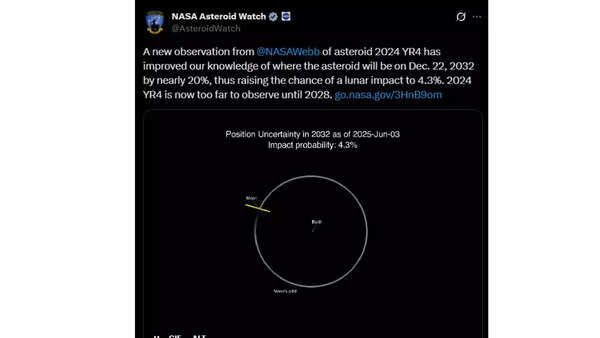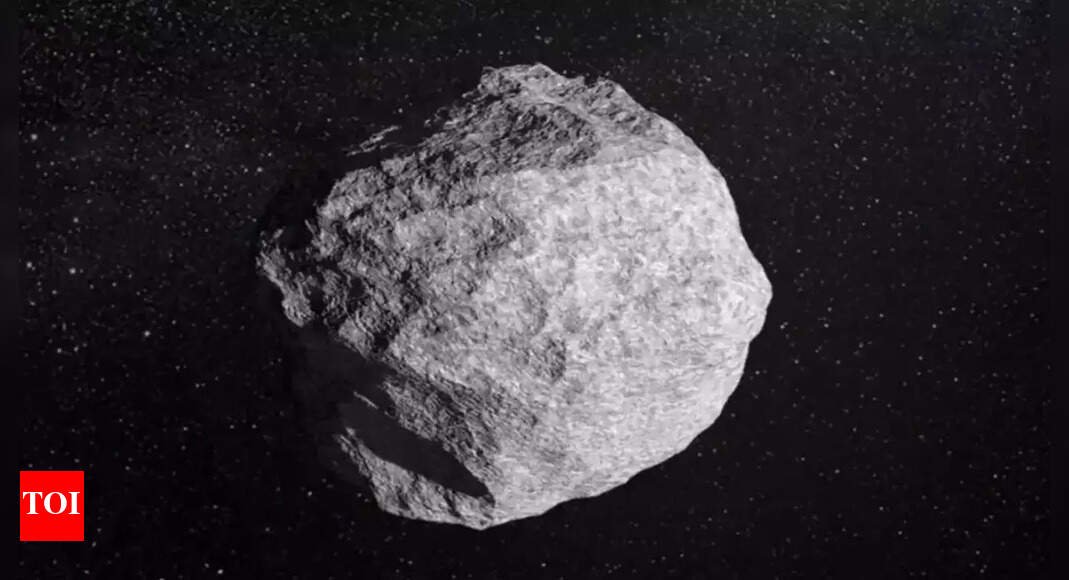Asteroid 2024 YR4 is not expected to strike Earth, but more and more, scientists worry that it could collide with the Moon. According to the experts at the University of Western Ontario caution that such an impact would hurl more than 100 million kilograms of rubbish into space. This fast-moving lunar material can be a grave hazard to satellites in low Earth orbit employed for communication, GPS, and climate observation and even put astronauts on the International Space Station (ISS) at risk. With increased satellite networks and human space activity, the severity of the implications of a Moon impact by asteroid 2024 YR4 calls for immediate international consideration and readiness.
City-killer asteroid 2024 YR4 could crash into moon, pose satellite danger
When 2024 YR4 was initially monitored, it seemed to be a potential threat to Earth. But subsequent observation eliminated a direct Earth impact. Instead, simulations now indicate a higher chance of it striking the Moon, with probabilities increasing from 3.8% to 4.3%. While that seems low, it is sufficient to lead scientists to track closely the asteroid’s path and simulate likely effects.If the asteroid does hit the Moon, the released energy might be the equivalent of 6.5 megatons of TNT-more than 400 times the Hiroshima bomb (0.015 megatons). A 1-kilometer-wide crater would probably be created by the impact, likely somewhere in the southern hemisphere of the Moon.The collision is thought to shoot approximately 100 million kilograms of lunar rock and dust into space-debris that will not simply disappear into thin air. Of greatest concern is that approximately 10% of the lunar debris may make its way towards Earth within days after impact. Most of it will be minuscule, but particles greater than 0.1 millimeters can be hazardous enough to penetrate or harm satellites and spacecraft. These pieces will remain in orbit, risking long-term damage to space-based infrastructure.

Source: X
Asteroid 2024 YR4 impact may risk satellites as orbital traffic increases
The number of satellites around the Earth is likely to surge exponentially by 2032 due to worldwide expansion in telecommunications, navigation, and observation of the Earth. Most of these satellites will be in low Earth orbit (LEO)—the very zone that would be impacted by debris from a lunar impact.The Western Ontario team of the university ran 10,000 simulations of impacts. In 410 of them, the asteroid struck the Moon head-on, and the next few days exhibited the densest concentrations of potentially destructive space debris. Although the study does not directly estimate the risk to human missions, the ISS itself orbits in LEO, so it is a potential target. Even small high-speed pieces of debris have the potential to cause catastrophic damage to spacecraft and threaten the lives of astronauts.

Asteroid 2024 YR4: Variables in the distribution of threat
Scientists highlight that a number of variables will determine the size and distribution of the threat:
- Location of impact on the Moon
- Speed and direction of asteroid
- Size of the crater
- Distribution and velocity of the debris ejected
- Various permutations of these variables will influence the amount that escapes the Moon’s gravity and the amount that gets to Earth’s proximity.
Asteroid 2024 YR4: Earth may be safe, but our satellites are not
Although Earth is not in the path of the asteroid, the indirect consequences of a collision with the Moon are significant enough to justify preparation. Contemporary existence relies on satellites for everything from the GPS and internet access to climate monitoring and scientific information. Any disruption in this system of orbits could have worldwide ramifications.This possible effect is a wake-up call for space agencies to spend money on orbital debris tracking, satellite shielding, and improved risk prediction technologies. Asteroid 2024 YR4 might never graze Earth, but if it crashes into the Moon, it might create havoc in our orbital environment. With over 100 million kilograms of space debris potentially entering Earth’s space, the incident highlights just how interdependent celestial bodies are—and how vital it is to track even remote space threats.Also Read | SpaceX’s Starship explodes during static fire test at the launch site – is it a major setback for Elon Musk?
var _mfq = window._mfq || [];
_mfq.push([“setVariable”, “toi_titan”, window.location.href]);
!(function(f, b, e, v, n, t, s) {
function loadFBEvents(isFBCampaignActive) {
if (!isFBCampaignActive) {
return;
}
(function(f, b, e, v, n, t, s) {
if (f.fbq) return;
n = f.fbq = function() {
n.callMethod ? n.callMethod(…arguments) : n.queue.push(arguments);
};
if (!f._fbq) f._fbq = n;
n.push = n;
n.loaded = !0;
n.version = ‘2.0’;
n.queue = [];
t = b.createElement(e);
t.async = !0;
t.defer = !0;
t.src = v;
s = b.getElementsByTagName(e)[0];
s.parentNode.insertBefore(t, s);
})(f, b, e, ‘https://connect.facebook.net/en_US/fbevents.js’, n, t, s);
fbq(‘init’, ‘593671331875494’);
fbq(‘track’, ‘PageView’);
};
function loadGtagEvents(isGoogleCampaignActive) {
if (!isGoogleCampaignActive) {
return;
}
var id = document.getElementById(‘toi-plus-google-campaign’);
if (id) {
return;
}
(function(f, b, e, v, n, t, s) {
t = b.createElement(e);
t.async = !0;
t.defer = !0;
t.src = v;
t.id = ‘toi-plus-google-campaign’;
s = b.getElementsByTagName(e)[0];
s.parentNode.insertBefore(t, s);
})(f, b, e, ‘https://www.googletagmanager.com/gtag/js?id=AW-877820074’, n, t, s);
};
function loadSurvicateJs(allowedSurvicateSections = []){
const section = window.location.pathname.split(‘/’)[1]
const isHomePageAllowed = window.location.pathname === ‘/’ && allowedSurvicateSections.includes(‘homepage’)
const ifAllowedOnAllPages = allowedSurvicateSections && allowedSurvicateSections.includes(‘all’);
if(allowedSurvicateSections.includes(section) || isHomePageAllowed || ifAllowedOnAllPages){
(function(w) {
function setAttributes() {
var prime_user_status = window.isPrime ? ‘paid’ : ‘free’ ;
var geoLocation = window?.geoinfo?.CountryCode ? window?.geoinfo?.CountryCode : ‘IN’ ;
w._sva.setVisitorTraits({
toi_user_subscription_status : prime_user_status,
toi_user_geolocation : geoLocation
});
}
if (w._sva && w._sva.setVisitorTraits) {
setAttributes();
} else {
w.addEventListener(“SurvicateReady”, setAttributes);
}
var s = document.createElement(‘script’);
s.src=”https://survey.survicate.com/workspaces/0be6ae9845d14a7c8ff08a7a00bd9b21/web_surveys.js”;
s.async = true;
var e = document.getElementsByTagName(‘script’)[0];
e.parentNode.insertBefore(s, e);
})(window);
}
}
window.TimesApps = window.TimesApps || {};
var TimesApps = window.TimesApps;
TimesApps.toiPlusEvents = function(config) {
var isConfigAvailable = “toiplus_site_settings” in f && “isFBCampaignActive” in f.toiplus_site_settings && “isGoogleCampaignActive” in f.toiplus_site_settings;
var isPrimeUser = window.isPrime;
var isPrimeUserLayout = window.isPrimeUserLayout;
if (isConfigAvailable && !isPrimeUser) {
loadGtagEvents(f.toiplus_site_settings.isGoogleCampaignActive);
loadFBEvents(f.toiplus_site_settings.isFBCampaignActive);
loadSurvicateJs(f.toiplus_site_settings.allowedSurvicateSections);
} else {
var JarvisUrl=”https://jarvis.indiatimes.com/v1/feeds/toi_plus/site_settings/643526e21443833f0c454615?db_env=published”;
window.getFromClient(JarvisUrl, function(config){
if (config) {
const allowedSectionSuricate = (isPrimeUserLayout) ? config?.allowedSurvicatePrimeSections : config?.allowedSurvicateSections
loadGtagEvents(config?.isGoogleCampaignActive);
loadFBEvents(config?.isFBCampaignActive);
loadSurvicateJs(allowedSectionSuricate);
}
})
}
};
})(
window,
document,
‘script’,
);
#City #killer #asteroid #hit #Moon #December #threaten #satellites #Earth #experts #warn



